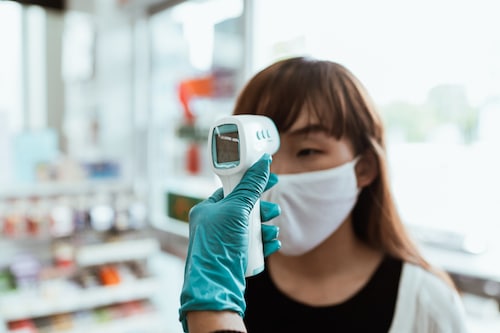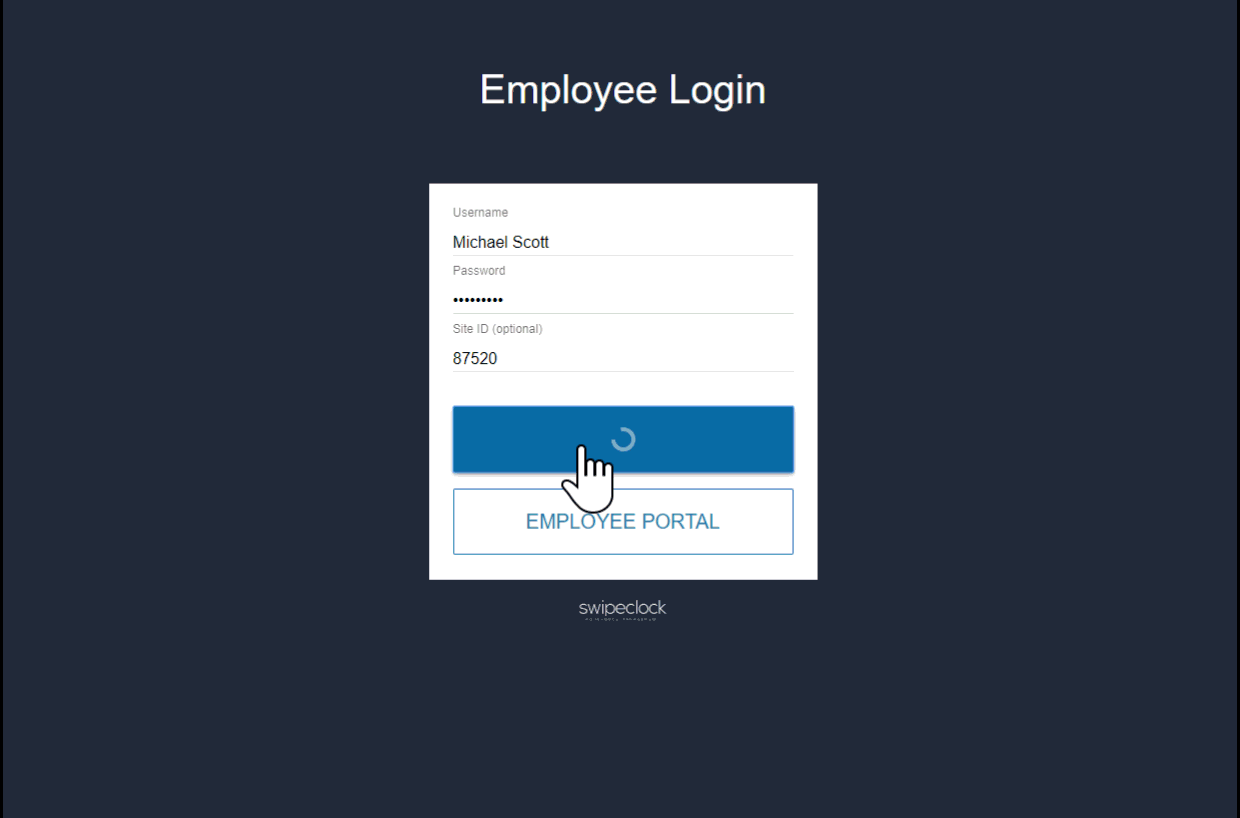Despite careful return-to-work planning, COVID-19 workplace outbreaks are still happening. Even though we are six months into this pandemic! To protect their businesses, employers are searching for ways to keep sick employees from coming to work.
Are you in the process of bringing your workforce back? Do you have successful return-to-work strategies? This may help: what if you could present an automated health survey at clock-in?
Screen for COVID-19 Symptoms At Clock-In
By now, most of us are familiar with the standard COVID-19 symptom questionnaires administered by most businesses. But when you’re the one administering these surveys to your employees each morning, it can take a toll on your productivity. So what if you could automate this process?
As an administrator in SDP Time, you create custom prompts for employees clocking in. When employees punch in, we can configure your clock-in screen to present a short health survey asking the employee if they are experiencing COVID-19 symptoms.
The CDC lists the following as possible symptoms of COVID-19 (note the additional symptoms added after the initial guidance was issued):
- Fever
- Chills
- Cough
- Shortness of breath
- Loss of taste or smell
- Sore throat
- Congestion or runny nose (appeared on CDC website May 13)
- Nausea (appeared on CDC website May 13)
- Diarrhea (appeared on CDC website May 13)
Before your employees clock in for their shifts, they must answer Yes or No to each symptom individually. You can present the survey in our web-based clock-in portal or in the prompt screen on the TimeWorksTouch hardware clock.
Then, supervisors or admin staff can review the answers in their manager portals. Employees and administrators can access SDP Time from any connected device. A web-based system is the safest way to handle clock-in regardless of whether you present a health survey.
This is how SDP Time screens for COVID-19 symptoms at clock-in:
A Useful Tool in Your Infection Control Toolkit
U.S. employers are retooling their operations to prevent COVID-19 outbreaks. You are probably using some combination of these successful return-to-work strategies:
- Encouraging frequent hand washing by making soap, water, and sanitizer readily available
- Frequently cleaning and sanitizing common areas and high-touch items
- Supporting physical distancing with occupancy limits, traffic flow floor markings, staggered schedules, plexiglass barriers, and reconfigured workstations
- Requiring masks and proper respiratory etiquette
- Checking employee temperatures before entering the workspace
- Maximizing work-from-home job roles
- Using virtual meetings where possible
- Screening employees for COVID-19 symptoms before they enter the workspace
- If an employee is found to have contracted the virus, performing contact tracing and notifying coworkers who could have been exposed
You may wonder why COVID-19 lab testing is not on this list. While some healthcare organizations and essential businesses are doing nasal swab tests, there are relatively few non-healthcare U.S. industries that are currently testing on a large scale.
It would be helpful if every employer could provide free testing to their employees. But even if that were possible, it wouldn’t negate the need for putting the other measures in place. Testing, like the other tools in your toolkit, is not a magic bullet on its own. Whether used with or in the absence of testing, employee symptom surveys can support your other measures.
As the coronavirus continues to infect more people, one of the biggest problems has been the lack of widespread testing. The COVID-19 test shortage means there’s very little definitive information about how the virus is making its way through communities. And while many corporations have already asked all employees who are able to work from home to do so, some others—such as grocery stores, factories, and other businesses tied to the supply chain—depend on in-person work, which makes monitoring people’s health critical. Fast Company
Why screen if COVID-19 can possibly be spread by people without symptoms?
Public health experts suspect that COVID-19 can be spread by people without symptoms. Scientists don’t yet know how much (if any) of the recent uptick in cases is due to asymptomatic spreaders. However, we do know for certain that people with active symptoms are a clear and present danger.
Clock-in symptom surveys won’t completely prevent the virus from entering your workplace. But screening for active symptoms is the best way to prevent sick employees from working. If you prevent sick employees from interacting with coworkers, you minimize the risk of an outbreak of any type of infectious illness at your business.
What if employees lie about symptoms?
As discussed, a symptom clock-in survey is one tool in your safety toolkit. As with all successful return-to-work strategies, you must train your staff and continually reinforce the training.
First, you identify your return-to-work safety policies. One of your hard-and-fast rules is that you forbid sick employees from coming to work. Period.
You want this policy to be crystal clear for your workforce. Make it front and center in your employee handbook. Teach it to new hires during onboarding. Remind employees every day in your HR portal. Instruct managers to continually reinforce safety practices with their teams.
Successful return-to-work practices should be standard operating procedures
Incorporate safety practices in job responsibilities and workflows. Employees are less likely to lie or forget about the rules when they are integral to job roles individually, team projects, and company-wide business operations. In short, your safety rules become part of your company culture.
How can I motivate employees to tell the truth?
First off, comply with the Emergency Paid Sick Leave Act. Make sure your employees understand that they will be paid if they miss work because they are sick. As discussed previously, use all avenues of communication to educate your team about your safety measures, including how to use sick leave.
Does your company culture discourage taking time off?
In the U.S., we have a hard-driving workaholic culture. Even though many companies offer generous PTO, actually taking a vacation is frowned upon. Employees regularly come to work even if they have a cold or (non-coronavirus) flu.
If that is the case in your organization, emphasize that COVID-19 is unlike the common cold or seasonal flu. A ‘just push through it’ mentality is not admirable when it comes to a deadly new disease for which there is no treatment or vaccine.
A global pandemic is a once-in-a-century event. If you have employees who dismiss the seriousness of the disease, remind them that they could infect a coworker who is at a higher risk of severe complications or death.
Fight the misconception that missing work threatens job security
Employees who conceal symptoms at work may believe it will help keep their job secure. It actually could have the opposite effect. If an infected employee interacted with coworkers, it could trigger an outbreak. This, in turn, could force the company to close until the outbreak was under control. A government entity could order the closure even if the business owner wanted to stay in operation.
It’s time for leadership to lead
Commend employees who report symptoms and stay home. Show that leadership is united behind the safety measures. Have each member of the executive team address your staff in a virtual meeting. It wouldn’t hurt to have members of the C-Suite speak to your workforce every couple of weeks.
Though we hear it every day, it bears repetition: we’re all in this together and everyone has a part to play.
Emphasize that preventing the spread of COVID-19 trumps the importance of any individual job responsibility. Even if productivity suffers in the short term, it is better for employees to stay home than risk infecting coworkers.
Screening workers and others entering the workplace for symptoms of COVID-19 and body temperature is a critical component of preventing transmission and protecting workers. Workers who are symptomatic upon arrival at work, or who become sick during the day, should immediately be separated from others. They should be sent to their home or a health care facility, as appropriate, and referred for further evaluation and testing in consultation with the state, territorial, or local health departments or through occupational health providers. Centers for Disease Control
New processes are most successful when combined with an existing workflow
If you have hourly employees who clock in and out for shifts, you may use some kind of time clock. Whether it’s a physical or web-based clock, each employee interacts with it at least twice per shift–when clocking in and clocking out. Add two more interactions if they have to punch out for lunch.
You may not need new software to automate symptom checking
If you already have a timekeeping system that is customizable, you may be able to use it for symptom checking.
It makes sense to use your existing technology. As discussed previously, when a new process is combined with an established workflow or tool, employees are quick to adopt it. In this situation, your employees couldn’t avoid it if they tried. They are already clocking in for their shift. The clock-in function prompts them to monitor how they feel and confirm they are symptom-free.
Let’s Talk
Employers are expected to do all in their power to keep employees safe. You only have so many tools in your infection-prevention toolkit. A clock-in symptom survey works in tandem with your other successful return-to-work practices.
Keep in mind that SDP Time is a unified HR solution. Employees can check their schedule, approve their timecard, and request vacation time whether they are working at home, in the office, or somewhere in between. But those are topics for another post.
For more resources on successful return-to-work strategies, visit our COVID-19 Business Resources Hub. And don’t forget to follow us out on Facebook, Twitter, and LinkedIn for even more business tips & tricks!
NOTE: Check the CDC website frequently for COVID-19 symptom updates and successful return-to-work strategies. CDC guidance on when a quarantined employee can return to work can be found here:
- Discontinuation of Isolation for Persons with COVID -19 Not in Healthcare Settings
- Discontinuation of Transmission-Based Precautions and Disposition of Patients with COVID-19 in Healthcare Settings (Interim Guidance)
Partner images & content provided by SwipeClock




